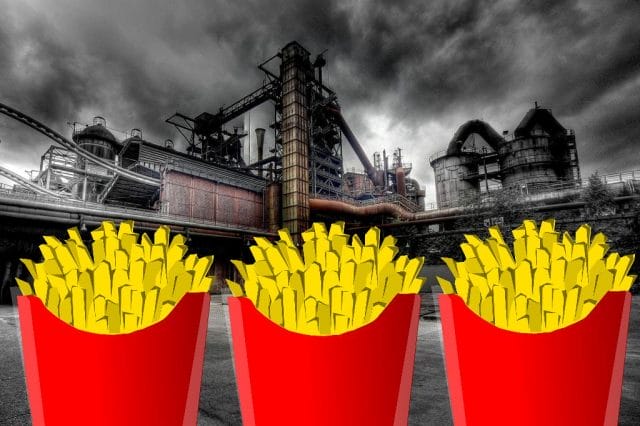
This article was written by Alex Mayyasi, a Priceonomics staff writer
Steel factory photo (sans french fries) courtesy of Till Krech
![]()
In 2011, during a debate over the nutritional guidelines for school lunches, Congress decided that pizza counts as a vegetable. And not for the first time.
The American government first proposed that an unhealthy food—if it contains trace amounts of a healthy ingredient—could count as a vegetable in 1981. Looking for ways to cut the school lunch budget, the Reagan Administration suggested that cafeterias include ingredients in condiments like pickle relish and ketchup toward nutritional requirements.
This was not good politics. Democrats and the press had a field day saying that Reagan had just classified ketchup as a vegetable. “This is one of the most ridiculous regulations I ever heard of,” Republican Senator John Heinz, owner of Heinz, told the press, “and I suppose I need not add that I know something about ketchup and relish.”
The Reagan Administration dropped the proposal, but it soon became law anyway. When the Obama Administration directed the Department of Agriculture to revise school lunch policies in 2011, experts took aim at the rule that allowed the tiny amount of tomato paste in pizza sauce to count toward the vegetable requirements of each meal.
Any changes made by the Department of Agriculture could jeopardize huge contracts for companies that supply food for school children’s lunches, so the food industry responded with a $5.6 million lobbying campaign. According to Margo Wootan, director of the Center for Science in the Public Interest, two multibillion dollar companies spent the most: Schwan and ConAgra, which each had large contracts for pizzas and fries used in school lunches.
Before the U.S. Department of Agriculture (USDA) could make any recommendations, Congress ensured that the push for healthier lunches did not hurt the manufacturers of unhealthy foods. Congress passed an agriculture appropriations bill that would deny the USDA funding to enforce any policies that prevented the potatoes in french fries or the tomato paste in pizza from counting as nutritional elements.
The press again enjoyed declaring that Congress had classified pizza as a vegetable. Cynics shrugged at yet another example of the government prioritizing the bottom line of businesses that manufacture sugary and salty processed foods over public health.
Yet the one-sided nature of the food industry’s lobbying is puzzling. Where were the broccoli, spinach, and carrot lobbies? Why didn’t a member of Congress take to the floor with a set of talking points provided by the leafy green vegetable lobby? Why can’t American farmers, who enjoy huge government subsidies, stand up to the processed food lobby?
Part of the answer lies in the economics of the food industry: the profit margins and scale of processed food makers gives them a heft that growers of healthy foods can’t match.
But it is also because “Big Ag” is not in the healthy food business. American farms with lobbying power don’t grow brussel sprouts; they grow grains used to make the high fructose corn syrup in Coke, the starches in processed foods, and the oil in deep fryers.
This is somewhat inevitable, but it is also a self-inflicted wound: the result of misguided government policy that subsidizes Big Macs and Big Gulps.
The Poor Margins of Broccoli Farmers
The words “food lobby” have become synonymous with unhealthy food.
In 2015, according to the Center for Responsive Politics, processed food manufacturers spent $32 million on lobbying while the fruit and vegetable industry spent a mere $3.7 million. Moreover, top fruit and vegetable contributors include the National Potato Council, which protects potato farmers’ interests in french fries, and a company that grows tomatoes for fast food chains.
To understand why the food lobby is dominated by companies pushing unhealthy foods, a good place to start is the huge imbalance between the amount of fruits and vegetables we should eat and the relative size of the fruits and vegetables market.
According to nutritional guidelines published by the USDA and the Harvard School of Public Health, fruits and vegetables should make up 50% of a healthy diet. But the financial value of the fruit and vegetable market is nowhere near 50% of the food industry. In 2015, American farmers earned under $50 billion in revenue from fruits and vegetables. In contrast, processed food manufacturers like ConAgra, General Mills, and Kellogg each make around $15 billion in yearly revenue.
The meat and carb heavy American diet partially explains these disparities. The Department of Agriculture estimates that Americans eat roughly 50% less fruits and vegetables and over 20% more grains and meat than recommended by its nutrition guidelines.
But it is the economics of the food industry that really explain why the food lobby pushes unhealthy fare.
Processed foods have high profit margins that fund advertising campaigns and lobbying budgets. The importance of branding also leads to consolidation that supports special interest lobbying.
We can see this in the case of cereal—one of the earliest processed foods.
When John Harvey Kellogg and Charles Post sold the first modern cereals in the 19th century, they worried about competitors. Their product was simply processed wheat or corn, and its production was cheap and easy to replicate.
Their solution was to use advertising to create brand names. Charles Post claimed his “Grape Nuts” could cure malaria. The Quaker symbol of Quaker Oats became the first nationally recognized cereal brand. As cereal manufacturers fought over the expanding market, they differentiated their fare through shapes and flavors—and added hefty doses of sugar to make it more palatable.
These dynamics apply to many processed foods: cheap foods differentiated—and sold at high margins—thanks to brand names and advertising. And in markets where brand recognition is key, a few businesses come to dominate. In 2015, Kellogg’s, which is currently valued at $26 billion, reported that of every $1 consumers spent on its cereal, it earned 35 cents of gross profit. (The most profitable vegetable farms earn 24 cents per dollar.)
Kellogg’s has a $26 billion market capitalization because it does not just make cereal. It also owns Pringles and manufactures a variety of processed foods from Eggo Waffles to Famous Amos chocolate chip cookies.
The entire processed foods industry is similarly consolidated. If you follow your favorite snack up the food chain, you’ll usually find that it is owned by a multinational company. PepsiCo owns Funyuns, Rold Gold pretzels, and Sun Chips. Ritz crackers, Oreos, and Wheat Thins sell under the Nabisco label, which is owned by Mondelēz International. So whenever a federal agency supports healthy foods, it picks a fight with a collection of the world’s largest companies.
It is possible to similarly market fruits and vegetables and sell them at a markup. Honeycrisp apples, which were designed for that satisfying crunch, enjoy a price premium two to three times that of other varieties. “Organic” has emerged as a powerful marketing tool, and prices of kale increased 25% over the past 3 years. Distributors use tactics like selling produce in convenient sizes (such as one snack worth of baby carrots) to differentiate their products.
In general, though, consumers don’t know or care who grew a certain apple or cucumber. The honeycrisp apple is a rarity, and trends like kale-mania benefit the entire market rather than a single company. Companies do market veggies, but brand recognition is low. Brands need a year-round presence in supermarkets so consumers can purchase it routinely, but produce is seasonal. Efforts to link recognized brands with a certain quality level and a higher price point is hindered by the influence of weather on quality and prices.
Farmers and companies that grow and sell produce do so at the going rate, which is a leaner business. Vegetable farms have had boom years and can make good margins. One USDA census has noted that the largest vegetable farms had annual sales of $500,000 on margins of 24%. But that’s still tiny compared to PepsiCo or General Mills, and the average farm actually loses value and relies on supplemental, non-farm incomes.
The term processed foods also applies to more than just Oreos and Doritos. When we think of pasta sauce, we normally don’t think of junk food. But as Michael Moss writes in the New York Times Magazine, products like Prego pasta sauce contain huge amounts of salt and sugar, just like potato chips and cereal.
The processed food industry, then, is profitable, politically powerful, and more enormous than we realize. Is it any surprise that the food lobby is synonymous with unhealthy foods?
The McDonaldization of the American Farm
While the economics of processed foods can explain their dominance over fruits, vegetables, and healthier fare, it may still seem surprising.
After all, American farmers receive billions of dollars in annual subsidies, and the American Farm Bureau often spends millions of dollars lobbying Congress to protect those subsidies and farmers’ interests. So why aren’t American farmers as successful in pushing legislation that favors fresh produce and “real food” as they are at winning subsidies?
The answer lies in recognizing that the prototypical American farm does not produce healthy food. The idyllic farms show in Whole Foods advertisements—farms with a variety of crops and livestock—are not representative of American agriculture. As food journalist Michael Pollan has written, America’s large commercial farms are monocultures, meaning they specialize in a single crop, which is usually a grain. Together, corn and soy account for almost 50% of all American crop revenues.
According to Rosamond Naylor and Walter Falcon of Stanford, America’s corn crop is used to produce half of the sweeteners Americans consume every year in beer and soda. The majority of the crop goes toward feeding cattle (46%) and ethanol production (25%). Corn also provides the starchy base for processed foods and the oil for McDonald’s deep fryers.
The dominance of grains in American agriculture is not unusual. Just four grains—corn, wheat, rice, and soy—account for so much of global agricultural output that economists modelling food prices only look at the market for these grains. Naylor and Falcon note that countries’ agriculture policy (including that of the United States) has been to increase the yields of these grains. After all, higher yields mean more productive farms, wealthier farmers, more food, and less hunger.
The American government has intervened extensively in agriculture since the Great Depression, and as food writer Michael Pollan notes, its subsidies and programs encouraged large farms that specialized in growing a single grain. The government promoted the research and production of chemical fertilizers, pesticides, and higher yield grains, and the Department of Agriculture encouraged farms to “get big or get out.” The government did not dole out decades of subsidies indiscriminately; it subsidized the production of corn, soybeans, wheat, and rice at a large scale.
In some ways, these policies have been a great success. American farms are profitable and productive: the average corn belt farmer produces enough crops to feed 140 Americans and makes around $200,000 in income. The average American now enjoys half a pound of meat per day—an amount once considered princely.
But the government’s calorie-maximizing policies no longer make sense in a country as troubled by obesity as by hunger. In its push for large monocultures, and in order to buy the peace of specialized vegetable farms, the USDA prohibited farms that receive grain subsidies from growing fruits and vegetables. (An ironic example of vegetable farmers flexing their lobbying muscles.) This puts the government in the insane position of subsidizing the cost of fast food while actively prohibiting more farms from growing fruits and vegetables.
Even farm animals, which are cheaper to raise when they can be fed with subsidized grain, have a mixed nutrition record. Most nutritionists consider meat part of a healthy diet, but they also believe Americans eat too much meat. In addition, grain subsidies, as well as the lack of any policy prohibiting the regular use of antibiotics in animal feed, enable farmers to raise animals at scale in confined areas. (The antibiotics keep animals alive in the filthy conditions of small cages.) Cheap meat is a great luxury, but this system makes McDonald’s hamburgers and Kentucky Fried Chicken cheaper than healthier foods.
America’s large, profitable farms spend millions on lobbying each year and enjoy substantial access to lawmakers. The problem is that almost none of these farms provide a counterweight to manufacturers of junk and processed foods. Thanks in part to outdated and politically-expedient agricultural policy, farms’ lobbying power protects french fries, Big Macs, and soda rather than leafy greens.
The Food Pyramid’s Corrupt Foundation
With this understanding of America’s food industry and its lobbying prowess, we can understand a certain mystery behind the food pyramid: why it promoted a diet at odds with the advice of nutritionists for nearly 20 years.
In 1992, the United States Department of Agriculture unveiled the food pyramid, its guide to healthy eating. Thanks to government efforts to publicize it—pushing it into doctors’ offices and home economics classes—the majority of Americans recognize the food pyramid. The nutritional guidelines behind the food pyramid also inform policy like school lunches and food stamps, making it the country’s most influential nutrition document.
During its 24-year lifespan, the food pyramid has changed significantly. The base of the original pyramid contained loaves of bread, plates of pasta, and bowls of cereal. But in the ‘food plate’, which replaced the pyramid in 2011, grains only take up 20% of the plate, which is dominated by fruits and vegetables.
The changes do not represent a new understanding of nutrition; the story of the food pyramid is the most highly visible demonstration of the food and agriculture sectors’ lobbying prowess.
Dr. Luise Light is a nutrition expert and led the team at the Department of Agriculture that made the original recommendations for the food pyramid. If you review her original recommendations, they sound similar to dietary advice given by nutritionists today: lots of vegetables, more lean sources of protein like fish and nuts, and less dairy and processed foods.
Those guidelines, according to Dr. Light, did not survive their trip to the office of the Head of the Department of Agriculture. She has described herself as “shocked” by the changes that were made. Her team placed fruits and vegetables at the base of the pyramid and whole-grain breads and cereals further up. The new guidelines not only switched carbohydrates to the base of the pyramid, they moved processed foods like crackers and corn flakes, which Dr. Light and her team had placed at the top of the pyramid with chocolate, to the base too. Even with all the edits, the food pyramid was not released for another 12 years.
With an understanding of the food lobby, it’s not hard to understand why. The companies that make processed foods and the large American farms that grow grains wanted to see carb-heavy foods promoted at the base of the pyramid; the tiny leafy greens lobby could not make its voice heard.
As in 1992, every five years, when the Department of Agriculture revisits its nutrition guidelines, the food industry gears up by releasing floods of reports, nominating friendly (and on-salary) researchers to be part of the USDA committee reviewing the policies, and appealing to allies in Congress and the White House.
This means that new policies are always a battle between public-interest organizations pushing for healthier guidelines and a food lobby working to subvert them. The result is that improving our food policy—at best—takes a step backward for every two steps forward.
***
The American government wields enormous influence over our diet. Federal policy shapes our farm system to a remarkable degree and sets the lunch menu for millions of schoolchildren. As long as food lobbyists overwhelmingly represent the makers of unhealthy food, health advocates will always struggle to push policy in a healthier direction.
To some extent, this is inevitable. The profit margins for making a branded bar of sugar are better than for growing brussel sprouts, which creates more money for lobbying against labelling laws, sugar taxes, and so on. But the current status quo, in which American farms grow crops for unhealthy products like high fructose corn syrup, is the result of outdated agricultural policy.
“Good advice about nutrition conflicts with the interests of many big industries,” Michael Jacobson, co-founder of the Center for Science in the Public Interest, has said, “each of which has more lobbying power than all the public-interest groups combined.” But the real problem is that manufacturers of unhealthy food are so powerful that those interests groups are always the pushing snack foods rather than fruit.
There’s a lot of money to be made selling obesity foods, and you can’t move America in a healthier direction without confronting the salty, sugary, finger-licking, just-one-more-chip financial firepower of the food industrial complex.
Our next post investigates the triumph of the average over the median and the mode. To get notified when we post it → join our email list.
![]()
If you’re a company that wants to work with Priceonomics to turn your data into great stories, learn more about the Priceonomics Data Studio.






